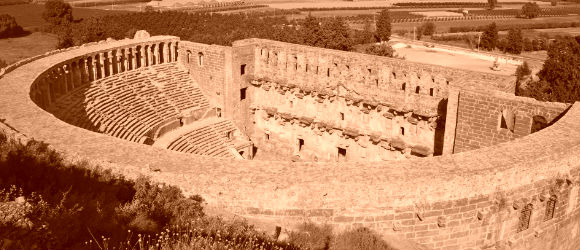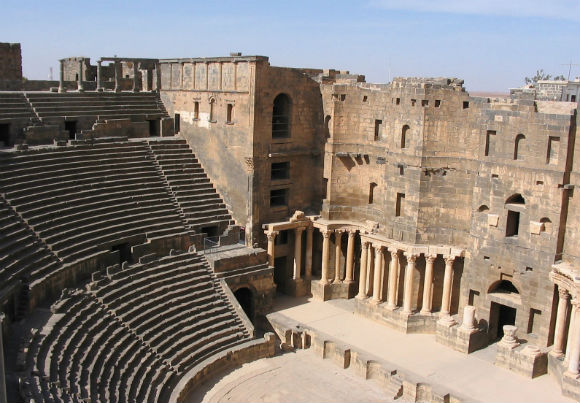Aspendos was an ancient Greco-Roman city in Antalya province of Turkey. It is located 7 kilometres (4.3 mi) northeast of central Serik.
Aspendos was an ancient city in Pamphylia, Asia Minor, located about 40 km east of the modern city of Antalya, Turkey. It was situated on the Eurymedon River about 16 km inland from the Mediterranean Sea; it shared a border with, and was hostile to, Side. According to later tradition, the (originally non-Greek) city was founded around 1000 BC by Greeks who may have come from Argos. The wide range of its coinage throughout the ancient world indicates that, in the 5th century BC, Aspendos had become the most important city in Pamphylia. At that time the Eurymedon River was navigable as far as Aspendos, and the city derived great wealth from a trade in salt, oil, and wool.
Aspendos did not play an important role in antiquity as a political force. Its political history during the colonization period corresponded to the currents of the Pamphylian region. Within this trend, after the colonial period, it remained for a time under Lycian hegemony. In 546 B.C. it came under Persian domination. The face that the city continued to mint coins in its own name, however, indicates that it had a great deal of freedom even under the Persians.
In 467 B.C. the statesman and military commander Cimon, and his fleet of 200 ships, destroyed the Persian navy based at the mouth of the river Eurymedon in a surprise attack. In order to crush to Persian land forces, he tricked the Persians by sending his best fighters to shore wearing the garments of the hostages he had seized earlier. When they saw these men, the Persians thought that they were compatriots freed by the enemy and arranged festivities in celebration. Taking advantage of this, Cimon landed and annihilated the Persians. Aspendos then became a member of the Attic-Delos Maritime league.
The Persians captured the city again in 411 B.C. and used it as a base. In 389 B.C. the commander of Athens, in an effort to regain some of the prestige that city had lost in the Peloponnesian Wars, anchored off the coast of Aspendos in an effort to secure its surrender. Hoping to avoid a new war, the people of Aspendos collected money among themselves and gave it to the commander, entreating him to retreat without causing any damage. Even though he took the money, he had his men trample all the crops in the fields. Enraged, the Aspendians stabbed and killed the Athenian commander in his tent.
When Alexander the Great marched into Aspendos in 333 B.C. after capturing Perge, the citizens sent envoys to him to request that he would not establish that he be given the taxes and horses that they had formerly paid as tribute to the Persian king. After reaching this agreement. Alexander went to Side, leaving a garrison there on the city’s surrender. Going back through Sillyon, he learned that the Aspendians had failed to ratify the agreement their envoys had proposed and were preparing to defend themselves. Alexander marched to the city immediately. When they saw Alexander returning with his troops, the Aspendians, who had retreated to their acropolis, again sent envoys to sue for peace. This time, however, they had to agree to very harsh terms; a Macedonian garrison would remain in the city and 100 gold talents as well as 4.000 horses would be given in tax annually.
In 190 BC the city surrendered to the Romans, who later pillaged it of its artistic treasures. Toward the end of the Roman period the city began a decline that continued throughout Byzantine times.
Aspendos,



The theatre at Aspendos is truly a remarkable structure. One can just sit and imagine a wathcing a production severla thousand years ago. There is one caution–the fake Roman that wishes to have his picture taken with you, can be agressive. Our guide had to asked him a leave several people in our group alone. I also would encourage people…
Wow, we were told to visit by our son, we took a Taxi from Side 120TL & he waited for us, a bargain as it turned out.
The size & beauty of the place leaves you speechless, it is almost intact, obvious renovation but well done. going almost to the top we were amazed to hear the people below clearly…
Aspendos Theater is great to see, but it’s more expensive to visit (15TL ea) compared to many other theaters and ruins to visit in the surrounding area. It’s located 40 mins from Side and 1 hour from Antalya, almost between these two cities. If I remember right it was also a separate fee to use the bathroom, and parking was…
On the orders of Kemal Ataturk the Theater was renovated it is just wonderful it must be amazing to watch a performance in there.
We booked to see the 'Troy' show at Aspendos, through Side Museum ticket office, only when we arrived it was not the Roman Amphitheatre but a modern mock up in the town. By this time I had assumed that I had mis-understood about Aspendos but now I know i had not. Make sure when you book you know which venue…
it's very strange to see a theater almost intact. It's not that far from Side, so it' an unique opportunity to expiere how such theater was in those days
Loved the ruins and our ability to go and move around where people did the same for hundreds of years.
Did this as part of a trip with Thomas Cook.
Really spectacular place and is incredible that it so well preserved, we spent about 1 hour at this attraction, which was enough.
Would have loved the opportunity to of been there with no other tourists to try out the famous acoustics..
This is even better than Nimes Has to be seen. Even the underneath corridors for animals can be seen.
This theatre is in amazing condition, it is worth the trip.
If you want a picture with the camel, don't let them take you "for a ride", because they will ask for more "lira"